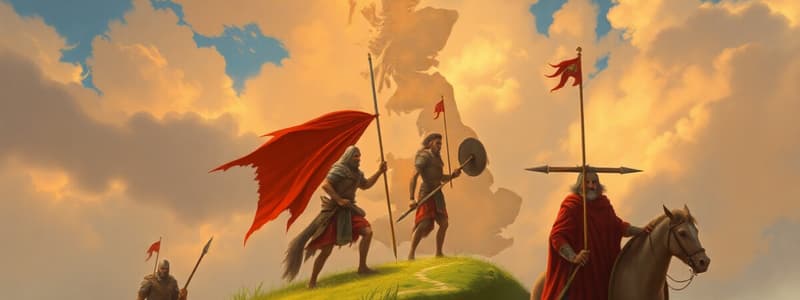Podcast
Questions and Answers
Flashcards
What is an illustration?
What is an illustration?
An image or drawing that represents a fact, idea, or story.
What are illustrations used for?
What are illustrations used for?
Pictures, drawings, or photos that help explain things.
What does it mean to illustrate something?
What does it mean to illustrate something?
To explain something clearly using words and pictures.
What's the purpose of an illustration in a story?
What's the purpose of an illustration in a story?
Signup and view all the flashcards
What is a historical account?
What is a historical account?
Signup and view all the flashcards
What does it mean to give an account of something?
What does it mean to give an account of something?
Signup and view all the flashcards
What information does a historical account usually include?
What information does a historical account usually include?
Signup and view all the flashcards
Who writes historical accounts?
Who writes historical accounts?
Signup and view all the flashcards
Study Notes
Anglo-Saxons
- The Anglo-Saxons were a mix of tribes from northern Germany, Denmark, and the Netherlands
- They migrated to Britain in large rowing boats
- After the Romans left Britain, the Anglo-Saxons began to arrive
- Some Anglo-Saxons lived peacefully, but many fought the British for land
- They brought their families with them to their new home
- The main tribes were the Angles, Saxons, and Jutes
- They raided the British coast from 360 CE, even before the Roman withdrawal
- They targeted villages and Roman villas, stealing gold, jewellery, and animals
- The Romans typically repelled the raids quickly
- After the Romans left, Anglo-Saxons settled in Britain permanently
Anglo-Saxon Rule
- Anglo-Saxons lacked a single ruler or emperor
- Each tribe had its own leader, controlling different parts of Britain
- Strong tribal leaders were called cyning (king)
- Each cyning ruled over a kingdom
- Tribes often fought amongst themselves for land
- By 600 CE, five main Anglo-Saxon kingdoms existed
- Kings were supported by advisors known as thanes
Anglo-Saxon Villages
- Villages were built by the Anglo-Saxons, not the Romans
- They often were built near water sources, such as rivers
- Villages were primarily agricultural
- Homes were simple, made of wood with thatched roofs
- Most homes had only one room
- Wooden fences protected homes and livestock from wild animals
- Shared fields were important for growing crops
- Villagers raised cattle, and grew wheat, barley, oats, and rye
Anglo-Saxon Children
- Boys learned practical skills like farming and warfare from a young age
- Around the age of 10, they began to imitate adult behaviours
- Girls learned household skills from their mothers
- Women's roles included cooking, childcare, and crafting
Studying That Suits You
Use AI to generate personalized quizzes and flashcards to suit your learning preferences.




